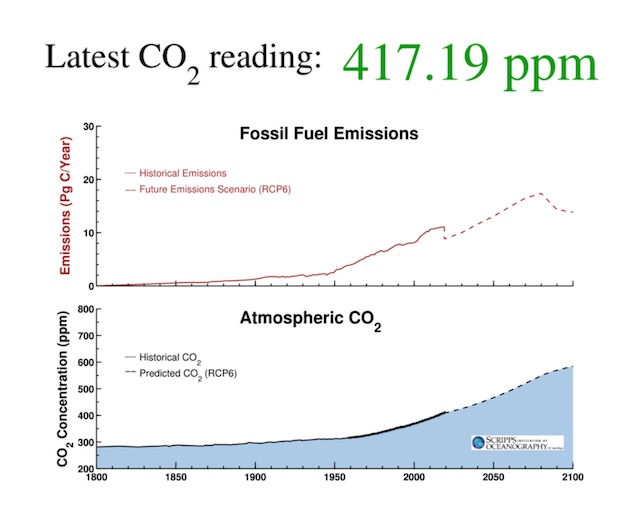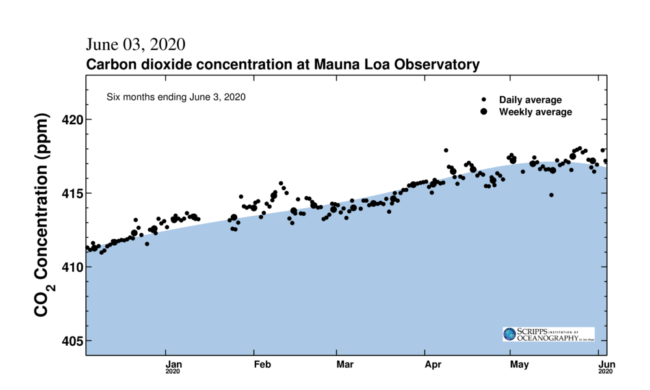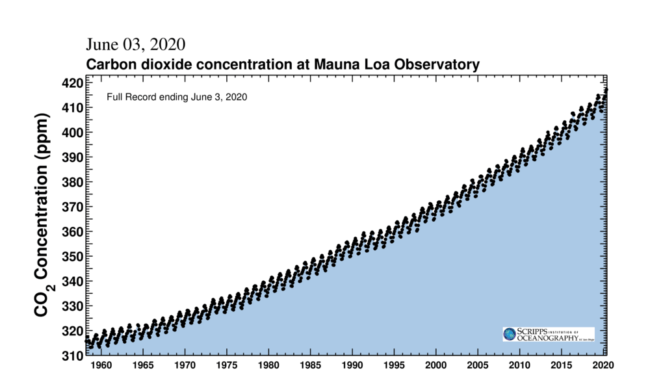
Atmospheric carbon dioxide measured at Mauna Loa Observatory reached a monthly peak exceeding 417 parts per million (ppm) in May 2020. This is the highest monthly total ever recorded. Despite the COVID-19 lockdown we have hit a new global high for CO2 emissions.
Here is what has been happening with those measurements over the last six months …

How are global CO2 emissions measured?
Far from any city, measurements are taken at the Mauna Loa Observatory on the island of Hawaii. This has been done from 1958 to the present day. The Mauna Loa observatory is a benchmark sampling location for CO2. Perched on a barren volcano in the middle of the Pacific Ocean, the observatory is ideally situated for sampling well-mixed air that is undisturbed by the influence of local pollution sources or vegetation. This location represents the global background for the northern hemisphere.
The measured curve is known as the Keeling curve because scientist Charles David Keeling, started the monitoring program and supervised it until his death in 2005. Since his passing, responsibility and oversight of the project was transferred to Keeling’s son, Ralph Keeling. On the fiftieth anniversary of the beginning of the project, the younger Keeling wrote an article in Science magazine describing his father’s life and work, along with how the project has grown and evolved over time. Along with more precise measurement materials and funds for the project of monitoring of the Earth’s CO2 levels, Keeling wrote his pride for his father’s work and how he has continued it in his memory.
Below is that complete record of measurements. Take note of where it was when you were born and how it has increased since then. You are breathing a mix of CO2 that none of your ancestors ever experienced …

New Record
This year’s peak value recorded by Scripps was 2.4 parts per million (ppm) higher than the 2019 peak of 414.8 ppm recorded in May 2019. Scripps scientists reported a May average of 417.2 ppm. NOAA scientists reported a May average of 417.1 ppm. (Side note: NOAA measure independently in a different location and so dual measurements like this are rock solid verification)
Monthly CO2 values at Mauna Loa first breached the 400 ppm threshold in 2014, and are now at levels not experienced by the atmosphere in several million years.
Why has COVID-19 Lockdown not had an impact?
The rate of increase during 2020 does not appear to reflect a reduction in pollution emissions due to the sharp, worldwide economic slowdown in response to the coronavirus pandemic. The reason is that the drop in emissions would need to be large enough to stand out from natural CO2 variability, caused by how plants and soils respond to seasonal and annual variations of temperature, humidity, soil moisture, etc. These natural variations are large, and so far the emissions reductions associated with COVID-19 do not stand out. If emissions reductions of 20 to 30 percent were sustained for six to 12 months, then the rate of increase of CO2 measured at Mauna Loa would be slowed.
“People may be surprised to hear that the response to the coronavirus outbreak hasn’t done more to influence CO2 levels,” said geochemist Ralph Keeling, who runs the Scripps Oceanography CO2 program, “but the buildup of CO2 is a bit like trash in a landfill. As we keep emitting, it keeps piling up. The crisis has slowed emissions, but not enough to show up perceptibly at Mauna Loa. What will matter much more is the trajectory we take coming out of this situation.”
The accelerating rate of increase in CO2
Even though terrestrial plants and the global ocean absorb an amount of CO2 equivalent to about half of 40 billion tons of CO2 pollution emitted by humans each year, the rate of CO2 increase in the atmosphere has been steadily accelerating. In the 1960s, the annual growth averaged about 0.8 ppm per year. It doubled to 1.6 ppm per year in the 1980s and remained steady at 1.5 ppm per year in the 1990s. The average growth rate again surged to 2.0 ppm per year in the 2000s, and increased to 2.4 ppm per year during the last decade.
“There is abundant and conclusive evidence” that the acceleration is caused by increased emissions, said Pieter Tans, senior scientist with NOAA’s Global Monitoring Laboratory.
“Progress in emissions reductions is not visible in the CO2 record,” Tans said. ”We continue to commit our planet – for centuries or longer – to more global heating, sea-level rise, and extreme weather events every year. If humans were to suddenly stop emitting CO2, it would take thousands of years for our CO2 emissions so far to be absorbed into the deep ocean and atmospheric CO2 to return to pre-industrial levels.”
“Well-understood physics tells us that the increasing levels of greenhouse gases are heating Earth’s surface, melting ice and accelerating sea-level rise,” Tans said. “If we do not stop greenhouse gases from rising further, especially CO2, large regions of the planet will become uninhabitable.”
CO2 at 417ppm – Further Reading
- The Keeling Curve Wikipedia page
- The Official site where you will find the daily readings
- Scripps Institution of Oceanography and NOAA Press release (June 4, 2020) – Rise of Carbon Dioxide Unabated : Seasonal peak exceeds 417 parts per million at Mauna Loa observatory
